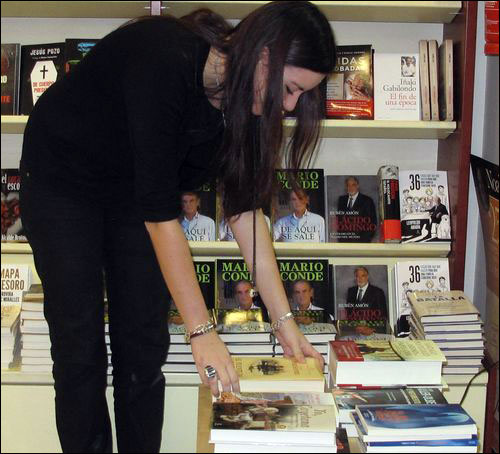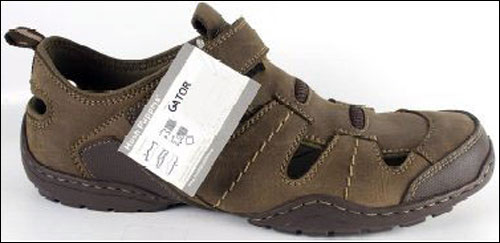When placed on display at stores, products are often picked up by customers for a closer look, and are then moved around the store and put back down, all before ever making it to the point of sale. Stores and manufacturers can learn from this behavior, by determining how much interest something like a book cover generates, as well as which sections of a store evoke the most interest among browsing shoppers. Retailers and goods manufacturers have data regarding the number of products sold, but few possess information indicating the level of customer interest prior to a sale.
Two Spanish retailers are tracking the popularity of selected items within their stores, using technology that detects which products are lifted off shelves, and how often. The stores are utilizing an RFID-based system provided by Spanish automatic-identification solutions company Cité Trade Tech. The firm is providing its Smart Data ISF solution, consisting of EPC Gen 2 passive ultrahigh-frequency (UHF) RFID tags, shelf readers and cloud-based software to analyze data.

Cité Trade Tech also offers a solution enabling customers to access additional information about a particular product by means of a Nexus S Near Field Communication (NFC)-enabled mobile phone, by tapping the phone against an NFC high-frequency (HF) RFID tag. “Currently, the system has been developed for the Android OS,” says Francisco Alegre, Cité Trade Tech’s CTO, “but it can develop quickly for a Windows phone or iPhone or iPad when there is an NFC SDK [software development kit] to work with these devices.” Thus far, the NFC system is not yet is use, though it is likely to be tested by stores this summer, says Marc Simon, Cité Trade Tech’s business development manager.
For the past four months, Cité Trade Tech’s Smart Data ISF solution has been utilized by a Hush Puppies shoe store, as well as the Argot bookstore. Both the Hush Puppies and Argot locations began employing the solution in late November 2011, ahead of the Christmas season.
Library Argot, which sells books in Castellón de la Plana, is using the system to track some of the 50,000 to 70,000 books that it has on its premises at any given time. “We had no way of knowing what happened with certain books from the time they were placed on the shelf until the sale,” explains Ismael Bonet, Argot’s CEO. Although store managers had been able to review daily sales records at the end of each day, he says, with an RFID system, the shop can learn, in real time, what interest a particular book is generating, “in which case more books could be stocked in the store, or moved, if necessary, where they could be more easily accessed.”
Store employees attach tags as the books arrive from publishers. The unique ID number encoded to each tag is linked to data about the book itself, including its publisher and title. That information is stored on the ISF software on a cloud-based server, which the retailer can then access. Currently, only several dozen book titles—recent releases prominently on display—are being tracked. Typically, between six and 18 books are read by a single shelf reader. Three readers are presently in use, installed under the tops of two tables measuring 50 centimeters by 50 centimeters (19.7 inches by 19.7 inches)—one on each of the two floors—and another table, measuring 30 centimeters by 50 centimeters (11.8 inches by 19.7 inches). In each case, a Cité Trade Tech reader interrogates the tags placed above it, and sends each tag’s unique ID to the Cité Trade Tech cloud-based server.
If a book is raised more than 20 to 30 centimeters (7.9 to 11.8 inches) from the table top, the interrogator can no longer receive a transmission from the book’s RFID tag, and that change in read status is forwarded to the software, which determines that the book has been picked up. Once the book is returned to the shelf, the reader resumes sending the tag’s unique ID number to the back-end system, indicating that the title has been returned rather than moved, or has been carried to the point of sale.
Library Argot shares the read data with the company that published the tagged books. “The editors analyze the success, and are able to react immediately,” Bonet states. “If a book does not generate data [indicating shoppers are picking it up], something is going on with it.” For publishers, he says, the solution can be to change the cover, while the system also enables them to increase the production of books based on the amount of interest they generate. Argot’s managers can also use the data to determine whether the surrounding environment or the book’s location is affecting interest, Bonet says.
According to Bonet, Argot has tested Cité Trade Tech’s NFC solution. “At the moment, we do not use NFC in the bookstore,” he says, though he adds that the retailer may opt to use the technology to provide customers (who own NFC-enabled phones) with more details about a book, as well as promotional offers related to that title. The use of NFC would necessitate that each category of product be provided with an NFC tag, against which a consumer could tap his or her phone, but would not require an NFC tag be placed on each product. If the store adopts the NFC solution, he says, he expects the technology to be utilized not only to provide additional details to shoppers, but also to enable consumers to collect loyalty points with the purchase of books.
The Hush Puppies store, located at the Gran Turia mall in Valencia, is also using the Smart Data ISF system to gain information regarding how customers handle products prior to purchase, says Daniel Mus, Hush Puppies Spain’s logistics and store manager. “We wanted to resolve the lack of information about which items were the most taken or liked,” Mus explains, and determine what may be “the hot points of sale at the store.” The EPC Gen 2 passive UHF RFID inlays are attached to paper hangtags on 50 to 60 shoes and boots displayed on one of three RFID-enabled shelves, one for each shop window. With the ISF system in place, the company can not only determine which items interest customers, but also which locations within the store may attract the most customer traffic. What’s more, for items frequently viewed, the solution can indicate how often those shoe models are then purchased. Since the system was installed several months ago, Mus says, “the store was able to optimize and increase sales, [by] changing the items’ location and positioning following the info supplied by the shelves.”


